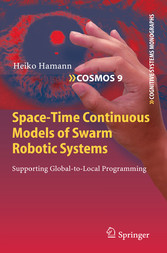Suchen und Finden
Service
Space-Time Continuous Models of Swarm Robotic Systems - Supporting Global-to-Local Programming
Heiko Hamann
Verlag Springer-Verlag, 2010
ISBN 9783642133770 , 160 Seiten
Format PDF, OL
Kopierschutz Wasserzeichen
Geräte
Title Page
2
Abstract
5
Contents
7
Introduction and Purpose
11
Objectives
12
Approach
13
Outline
13
Fundamentals of Swarm Robotics – An Interdisciplinary Approach
14
Definition of Fundamental Concepts
14
Agent
14
Agent–Agent Interaction
15
Macroscopic and Microscopic Level
15
Phenomenological Approach
15
Self-organization
16
Emergence
16
Stigmergy
18
Micro-Macro Link
18
Swarm Intelligence
18
From Natural to Artificial Swarms
19
Swarms as Problem Solvers
19
Robotics
20
Mobile Robotics
20
Micro-Robotics
20
Swarm Robotics
21
Embodied Cognitive Science
24
Sensor/Actuator Networks
24
Software Concepts for Distributed Systems
25
(Distributed) Artificial Intelligence and Multi-robot Systems
25
Multi-Agent Systems
25
Artificial Life
26
Amorphous Computing
26
Self-awareness in Distributed Systems
27
Science of Self-organization
27
Theory of Dissipative Structures
27
Synergetics
28
Philosophical Issues
29
Emergence and Novelty
29
Multi-particle Systems and Computation
33
Summary
34
State-of-the-Art in Modeling and Design of Swarms
36
Modeling Swarm Behavior and Collective Behavior
36
Agent-Based Modeling
36
Classical Approach – Control Theory
37
Swarm Robotics
37
Physics
38
Chemistry
39
Biology
41
Micro, Macro, and Stochastic Modeling – Road Traffic
42
Design of Emergent Behavior
44
Global-to-Local Programming – Engineering of Emergence
44
Antagonism of Concepts
44
Programming “by Hand”
45
Automatic and Semi-automatic Methods
47
Summary
48
A Framework of Models for Swarm Robotic Systems
49
Modeling Multi-particle Systems – Example of Brownian Motion
49
Introduction – History of Brownian Motion
50
A Microscopic Model – The Langevin Equation
50
A Macroscopic Model – The Fokker–Planck Equation
55
Discussion of the Methodology
64
Purpose of a Model in the Design of Swarm Algorithms
65
Benefits of a Symbolic Model
66
Consideration of Alternative Methods
67
A Physically Motivated Approach
68
Modeling Robot Motion
69
Modeling Robot-Robot Interactions
73
External Influence – Modeling the Environment
73
Challenge of Modeling Communication
74
Towards General Methodological Principles
75
Relevance to the Concept of Computation
76
From Swarm Behavior to World-Embedded Computation
76
The Concept of Embodied Computation
77
Discussion
79
Discussion of Limitations
79
Discussion of Benefits
81
Discussion of the Relevance to Computation
82
Summary
83
Validation by Results of Experiments and Simulations
85
Collision-Based Adaptive Swarm Aggregation
85
The Swarm Robot “Jasmine”
86
Scenario
87
Model
89
Results
92
Discussion
95
Collective Perception
97
Scenario
97
Model
100
Results and Discussion
104
Emergent Taxis
108
Scenario
108
Model
109
Results
112
Foraging
113
Scenario
113
Model
115
Results
117
Robot Aggregation as a Form of Computation
121
The Euclidean Steiner Tree Problem
122
Growing Random Trees
123
Results
126
Discussion
129
Summary
129
Conclusion and Outlook
131
Conclusion
131
Outlook
132
Acknowledgments
133
Appendix A Numerical Simulation of the Langevin Equation
134
Appendix B Simple Numerical Solver of the Fokker–PlanckEquation
136
References
138
Index
150
Service
Shop



